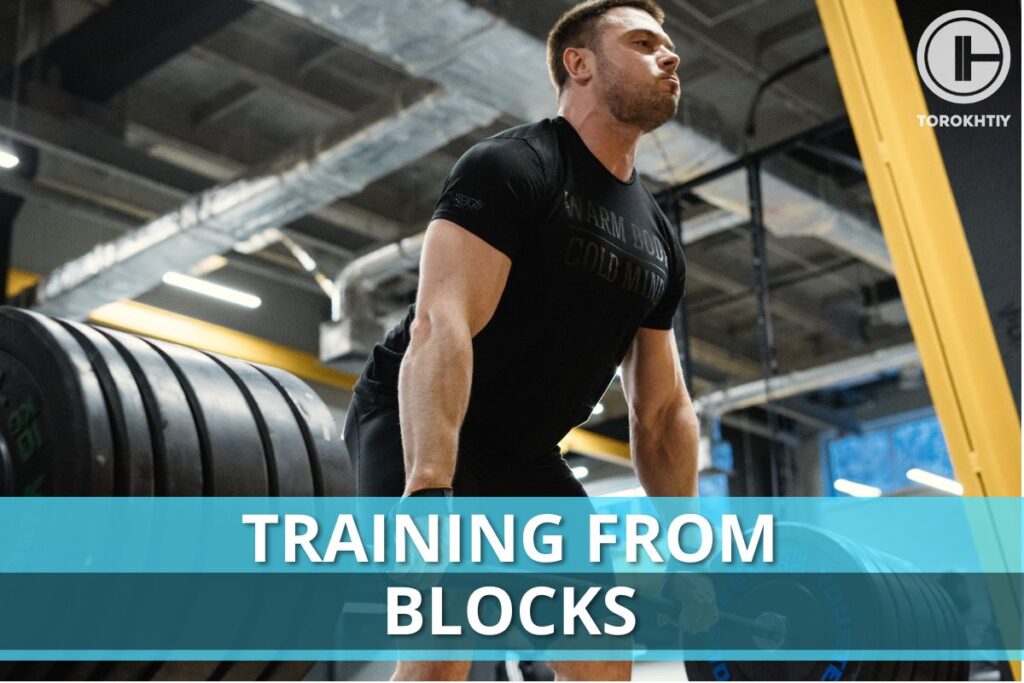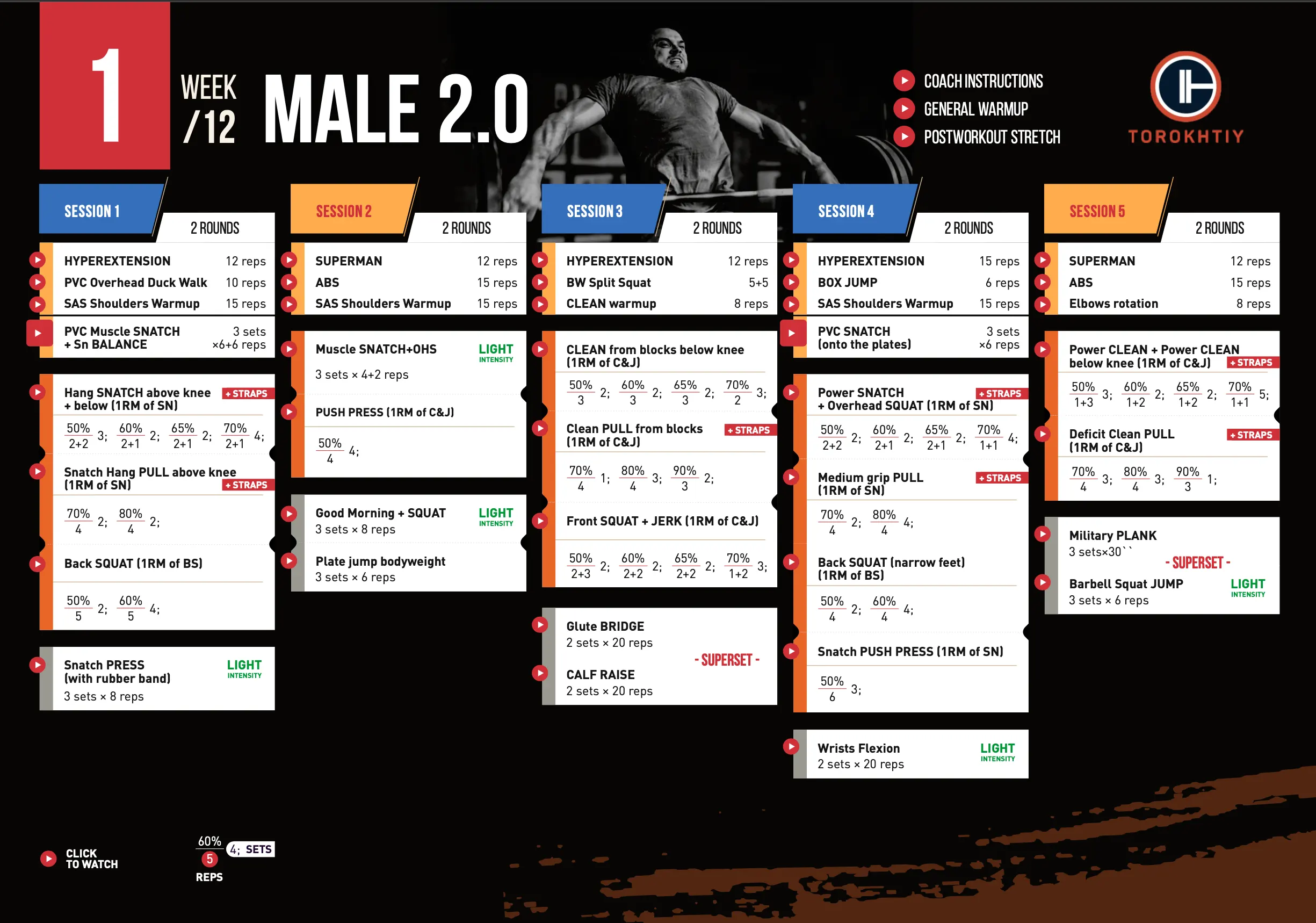Training From Blocks
Author:
Unlock your full potential by engaging with our experts and community! Have questions about your fitness journey or looking for expert advice on weightlifting techniques? Don’t hesitate — leave a comment below and Oleksiy Torokhtiy will provide a personalized answer and insights to help you reach your goals.
Torokhtiy is reader-supported. Some links are affiliate links, and we may earn a commission at no extra cost to you. See our disclosure page for details.
Lifting from blocks is the execution of any snatches, cleans, pulls from a height that exceeds the starting position. As a rule, their width is from 30 to 60 cm, and the height varies both from the height of the athlete and from the task of the exercise that must be performed. Most often, when working with blocks, the bar is located at the level of the knee joints, as well as above or below.

The main tasks that the exercises from the blocks solve are the development of individual phases of the pull, including full extension, catching and fixing the bar in snatch exercises and clean variations.
Some athletes fundamentally do not use blocks in their training process and argue that hanging exercises completely replace this type of work. But there is a huge difference between these types of auxiliary exercises: regardless of the starting point, the movement when performing the exercise from the blocks, the barbell has no motion vector and starting speed.
There is always minimal back work from the hang position, the ability to “adjust” to the barbell. These differences create certain advantages of training from blocks: the skill to instantly accelerate the barbell to its maximum speed. Also, a short pull forces you to consistently and engage your arms after the end of the maximum acceleration phase.
You may like it:
- Detailed Olympic Weightlifting Program For Beginners
- 12-Week Weightlifting Program For Women (Detailed Example)
- Create Your Olympic Weightlifting Program (Examples Included)
In my opinion, blocks are not the # 1 equipment and many great weightlifters do not use them in their training. But blocks have one good advantage: they allow you to work “near injury”. When an athlete has severe muscle soreness under load or a back or knee microtrauma, training from the blocks will help to “distance” this discomfort and allow the load to be carried out.
Do not in any way think that this is a call to train with injuries, no. This is just an explanation of how important it is for a coach to modify the training program depending on the situation and not be afraid to experiment with “comfortable” starting positions without pain. And about in which case it is better to skip a workout, you can read here.
During my sports career, I have seen many weightlifters who snatched the results from the blocks higher than in competitive exercises. This is large since the constitution of the body and the peculiarities of technique, these weightlifters were able to generate maximum power in such positions. When training from blocks, safety is an important nuance.
The problem is that if the athlete fails to catch the bar and it falls, then it can land on the corner of the block and bounce in an unexpected direction, and cause damage or even injury. My advice: you need to carefully lower the bar from a height no more than chest level.
If the athlete performed a snatch and stood with the barbell over his head on straight legs, then it is safer to lower the barbell to the platform in front of or behind the blocks. Not every athlete will like and suit this way of training.
Follow us!

Free!
Get a 2-week Weightlifting Program as a bonus for the subscription to kickstart your training plan!

Free!
But for the beginners (2-3 years of training) To improve the variability of the technique, in my opinion, it is necessary, once every 1-2 weeks, to include block training in preparatory exercises with an average intensity (70-80%) for 2-4 reps.
At the same time, it is also not worth working from the blocks too often, as this can form a movement pattern that will negatively affect your competitive performance.
The athlete also gains several advantages when working in pulls from the blocks:
- The ability to work on specific technical elements (“feel” the foot, work out the knee extension, set the position of the torso);
- Work with heavy weights to develop absolute strength and power (often representatives of “high” sports work from the blocks, since they are not comfortable taking a standard starting position).
So, the use of blocks is justified when:
- Working out the technique of the pull;
- Development of bar acceleration in separate parts of the pull;
- Improving the speed of going under the bar;
- Improving the hands work: in a snatch – the direction of the elbows up, in clean – elbows rotation;
- The development of absolute and explosive strength for weightlifting and other sports.
Wish power, speed and heavy kilos on the bar to ya ALL !!
Why Trust Us?
With over 20 years in Olympic weightlifting, strength training, nutrition coaching, and general fitness our team does its best to provide the audience with ultimate support and meet the needs and requirements of advanced athletes and professional lifters, as well as people who strive to open new opportunities and develop their physical capabilities with us.
By trusting the recommendations of our certified experts in coaching, nutrition, and sports training programming, as well as scientific consultants, and physiotherapists, we provide you with thorough, well-considered, and scientifically proven content. All the information given in the articles concerning workout programming, separate exercises, and athletic performance, in general, is based on verified data.
The product testing process is described in more detail here.
Author: Oleksiy Torokhtiy
Olympic Weightlifting Champion, PhD in Sport Science
Best Results: Snatch – 200 kg,
C&J – 240 kg
Oleksiy Torokhtiy is a professional athlete boasting 20 years of experience in Olympic weightlifting. With multiple European and World titles under his belt, he has showcased his prowess in two Olympic Games (Beijing 2008 and London 2012). Upon concluding his illustrious career, Oleksiy dedicated himself to coaching. By 2022, he had conducted over 200 weightlifting seminars worldwide. He is the visionary behind an international sportswear and accessories brand known for its motto, “Warm Body Cold Mind.” Additionally, he is an esteemed author and the creator of a series of training programs and eBooks.




Still have questions after reading our article? Unlock your full potential by engaging with our experts and community! Don’t hesitate — leave a comment below and Oleksiy Torokhtiy will provide a personalized answer and insights to help you reach your goals.